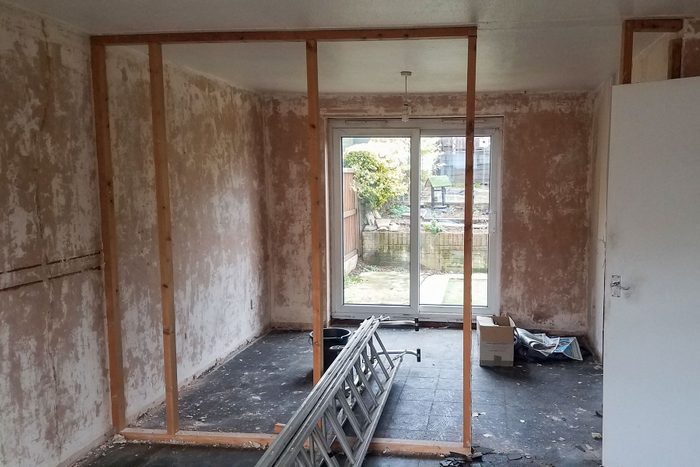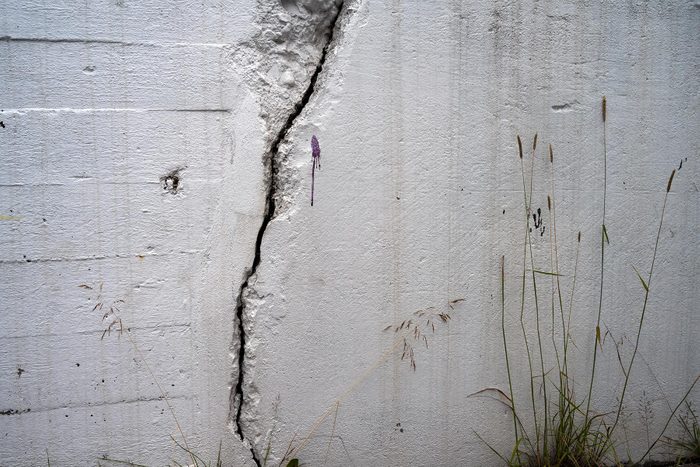Buying a fixer upper can be a great way to save money, but beware of these pitfalls that will quickly drain your bank account.
10 Signs a Fixer Upper Is a Money Pit

Crooked Rooflines, Walls and Floors
When looking at a home, check for straight ceilings, walls, floors and rooflines. Any sagging or bowing could indicate an issue with structural elements. Check the roof or ridgeline before entering the home.
“If the ridgeline isn’t perfect, that’s a sign the foundation may have shifted and has translated through all parts of the home,” says James Angell, a licensed home inspector with Angell Home Inspections. “It’s very costly to fix.”
Crooked rooflines can also, but not always, be associated with other uneven structural elements like walls, ceilings and floors. Walls should be plumb without large cracks, bowing or leaning. Ceilings and floors should also be straight and flat. And beware of excessively uneven surfaces.
“In an old house they’ll be some deviation of the floor, but if they slope severely to one corner something could be wrong with the foundation,” says John Rodkey of JMR Inspections.

Water Intrusion Problems
Water can find its way into a home through a leaky roof, damp basement and compromised exterior siding. Once water gets in, it can lead to rotted wood, foundation issues, mold and insect infestations.
Some telltale signs include visible mold, water stains on the ceiling or walls, soft wood or the presence of insects. Angell says when inspecting a home, he also looks to see if the ground grades away from the foundation. And he makes sure the roof is in good condition with proper gutter systems.
The integrity of the roof and siding should be closely examined during inspection. Look for missing siding, or cracks or holes in siding material.
“One of the biggest issues we’re seeing lately is with stucco siding,” says Reuben Saltzman, CEO of StructureTech, a home inspection company. “It gets cracks in it and allows water into the home, which causes a whole host of issues.”

Outdated Systems
An older fixer upper may have many endearing features. But if the major electrical, plumbing and heating systems haven’t been modernized, it’s sure to be a money pit.
To check for outdated electrical systems, Rodkey says, “Look for things like old push button [light] switches, drop cord light fixtures with cloth-wound insulation and two prong receptacles.” These can all be evidence of knob and tube wiring somewhere in the home.
Depending on the size of the home, rewiring can be costly, with a national average of $4,700 for a 1,000 square foot home.
Old boilers and furnaces can also be expensive to update. Some signs to look for include water on the floor near the unit and loud noises during operation.
Replacing aging boilers with newer models costs thousands, especially if asbestos was used on the heat box or pipes. That requires specialized removal. “Depending on the efficiency [of the new boiler or furnace], you can pay anywhere from $10,000 to $35,000 to have one replaced,” Rodkey says.
Cast iron pipes, low water flow and discolored water can all be signs of aging plumbing that’s also costly to replace.

Roofing Issues
Aging roof shingles and leaking roofs can lead to moisture issues in the home and a different set of problems.
While a sagging roofline is easy to spot, a leaky roof isn’t. “There are a lot of instances where the rooftop appears OK, but once we’re looking inside there are all sorts of conditions that would merit a rooftop replacement,” says Anton Britting, a certified home inspector with Journey Property Inspections.
Roof issues can include a leaking chimney, moldy sheathing or new shingles installed over rotten sheathing. Visible signs in the attic can include mold or water stains on the sheathing. Look for water stains on the ceilings below, too. It’s costly to replace the roofing as well as remedy any secondary moisture issues.

Retaining Walls
Make note of any retaining walls on the property. They serve an important function, and need to be addressed if they show evidence of disrepair or failure. Signs include bulges, cracks and leaning away from the hillside.
Repairing or replacing a failing retaining wall can be prohibitively expensive since it requires heavy equipment and possibly an engineer. “Anything that requires excavation I see as a huge undertaking,” Britting says. Adds Saltzman: “Most people underestimate the cost of [retaining walls]. You’re talking tens of thousands [of dollars to repair].”

Neglected In-Ground Pool
If your target fixer-upper has an in-ground pool, proceed with caution. Chances are, if the homeowner failed to properly maintain the home, the pool won’t be in great shape, either. Look for signs of neglect like an uncovered pool with green water, shifting concrete around the deck, a sagging liner and overgrown weeds in the pool area.
Replacing the liner on a standard-sized in-ground pool will cost $1,000 to $6,000 or more, and repairing shifting concrete or replacing a pool deck can cost tens of thousands of dollars. Then there are broken pumps, ruptured water lines, cracked pool shells and filters to consider.
If the pool is beyond repair, backfilling it, i.e. filling it in with dirt and covering it with sod, is not cheap either. Expect to pay between $2,500 and $12,000 to fill in a neglected pool.

Driveways in Disrepair
If the home has an asphalt or concrete driveway, take a good look at it. If it’s failing, snow removal will be that much harder. Plus, they’re unsightly and detract from a home’s curb appeal.
“If all of your neighbors have nice looking driveways and yours is the only sorry looking one, you’re probably going to want to do something about it,” Saltzman says.
For concrete driveways, look for large cracks and shifted panels that heave up or sink lower than the rest. For asphalt driveways, look for large areas of ‘spidering’ (i.e. small cracks that connect to each other), sunken areas, large cracks, heaving or missing pieces.
Depending on the length and condition of the driveway, it can be costly to remove and replace. Minor repairs and reconditioning is DIY-able, but installation of a new driveway will require a contractor. Expect to pay $7 to $24 per square foot for concrete or asphalt driveways.

Problematic Trees
The old saying goes, “The best time to plant a tree is twenty years ago.” Sometimes the best time to cut down a tree is twenty years ago, too.
Trees can offer many benefits to a home, but overgrown or diseased trees can be expensive to remove. Dead trees can be dangerous if they fall. Same with really tall softwood species like pine, which can break easily in storms. Trees planted too close to a house can act as a highway for bugs to enter the home, or damage foundations or sewer lines with wandering roots.
Removal can be expensive, depending on the size of the tree and whether removal crews and equipment can easily access it.
“The biggest thing that we see is probably large, dying or diseased trees on the property,” Saltzman says. “Those can be extremely expensive to remove, and sometimes the insurance company will require you to address it, or they’ll drop your insurance.”

Foundation Issues
Nothing says money pit quite like foundation issues. When viewing a fixer upper home, look carefully in the basement for signs of problems.
“Small hairline cracks are little to no concern,” Saltzman says. “But larger cracks, bulging and leaning [walls] are definitely worthy of further evaluation by a foundation specialist.”
Also look around the exterior for possible causes of foundation issues, often caused by poor drainage. According to Angell, this can result from a lack of gutters, downspouts discharging next to the foundation, or ground that doesn’t slope away from the house.
Water can displace or disrupt the soil supporting a foundation, leading it to shift and crack. These cracks then let in water and cause further damage. Depending on the extent of the damage, repairs can involve large construction equipment and a team of professionals with huge price tags.

Problematic Sewer Lines
A sewer main line connects a home’s drainage pipes to a municipal sewer system or septic tank, and these can be really expensive to repair or replace.
Because a main line is often found under the foundation and runs underground to the street or septic tank, detecting problems can be a challenge. Signs inside the home may include foul smells in the basement and multiple slow or backed-up drains.
However, sometimes there are no warning signs. Issues can only be detected through a sewer inspection, when a camera is sent down the line to check its condition.
Repair work requires yard excavation and possible removal of a portion of the basement floor to access the line. Sewer inspections are a separate service from home inspection, but most inspectors offer it.
“It has become standard practice to get a sewer inspection along with a home inspection, because sewer lines are so expensive to repair,” Saltzman says.




















